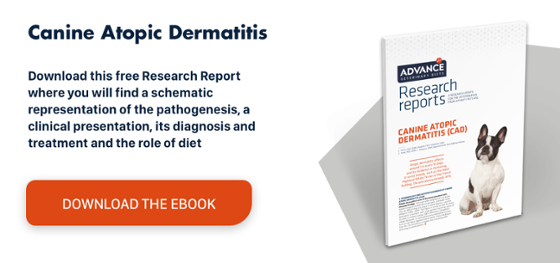Eczema in dogs: causes of pyotraumatic dermatitis or wet eczema
Eczema in dogs: hot spot
Although the term hot spot is commonly used in dermatology to refer to other processes, its most accurate use is in the context of pyotraumatic dermatitis, as discussed in this article. It is characterised by an acute bacterial infection secondary to self-inflicted trauma. It is a round, reddish-yellow, moist lesion that develops and spreads quickly, either with or without emerging hairs. Eczema causes considerable itchiness and pain, so dogs focus on, lick and then bite the area.
Diagnosis and treatment
Diagnosis is usually rapid and accurate, as it is a very characteristic and common lesion, but we can support our presumptive diagnosis with cytology to confirm the presence of bacteria and inflammatory cells. Bacterial cultures are indicated for patients with an insufficient treatment response.
Hot spots are a relatively easy problem to solve. The challenge usually lies in finding out why it has occurred, which is very important when trying to define the treatment and ensure its long-term effectiveness. The first step when treating hot spots is to shave the area in order to increase the efficacy of antiseptic solutions. Antibiotics (oral and/or topical) and anti-inflammatories are necessary in most cases, and last but not least, patients should wear an Elizabethan collar so they cannot touch the wound and perpetuate the lesion. If the pyotraumatic dermatitis is due to a flea bite allergy (FAD), complete external parasite control is essential and corticosteroids may be needed to bring the allergic reaction under control.
The medical therapy should be supported with products that help restore the skin’s natural protective layer, such as shampoos with phytosphingosine or nutritional supplements including fatty acids. Shampoo therapy is proving very effective at moisturising and maintaining the skin’s physiological pH, while also calming the itching.
Aetiology
Although it is a very common lesion in everyday clinical practice, its aetiology is not entirely clear. It is known to be triggered by any one of a wide range of pruritic stimuli, but the predisposing causes have not been studied in depth.
The aim of this prospective study was to investigate the correlations between pyotraumatic dermatitis, the histopathology of the lesions and potential predisposing causes.
The study conducted a statistical analysis of 44 dogs aged 4 years or under. The lesions were most commonly found on the neck, cheek and outer thigh, and there was a significant relationship between breeds and the site of the lesions. With regard to seasonality and environmental factors, the study was carried out in an area where fleas were not endemic and there was no apparent association between the time of year and the lesion and its cause, nor with the dogs’ age or sex.
The sample included 14 breeds and the most affected were Golden Retriever, German Shepherd and Rottweiler.
In terms of their histopathology, the lesions could be divided into four types according to the presence/absence of eosinophils and folliculitis. There was no clear relationship between histopathology and age, breed or sex, but 29 cases had eosinophils in the lesion and 20 of the dogs suffered from acute folliculitis.
In conclusion, there does not seem to be any correlation between the histopathological results and other characteristics, but we can consider that there is a breed-related predisposition and that hot spots have a histopathology aspect.


